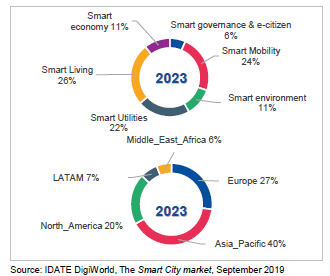As cities drive public smart city strategy, our interest was to catch their financing capacity for implementing smart city projects.
Cities (co)financing or enabling smart city initiatives
Cities’ spending on their smart city strategy and projects represents only a portion of the total smart city market, which is also populated by private sector players and other levels of government (central, federal and intermediate). Municipal spending nevertheless remains central to all smart city initiatives nationwide.
In 2019, cities spent an estimated 87 billion USD, a figure that is expected to increase by 120% by 2023, and so bringing cities’ potential financial expenditures on smart city initiatives within 5 years to more than 190 billion USD. Cities (co)financing or enabling smart city initiatives.
Three main market drivers:
- The maturity and sustainability of the infrastructures that undergird urban innovation;
- Mobilisation and pooling of financial support through various mechanisms (smart PPP, experience sharing platforms, national programmes…);
- The deployment of 2nd generation smart cities, covering a wider range of areas and priorities (with particular focus on social and environmental issues)

A growing market, both regionally and in the various “smart” areas
- Markets in the Asia/Pacific and Middle East/Africa regions are projected to enjoy the strongest 5-year growth.
- Asia/Pacific will account for close to 40% of global market growth over the next 5 years, compared to only 6% for the Middle East/Africa region.
- If pioneer smart city initiatives’ core priorities (living, mobility, utilities) are still key areas of focus, a growing amount of cities’ resources will be devoted to smart environmental and economic initiatives in the coming years.

Want to know more about Smart City market?
Check out our latest report
The Smart City Market
More info
